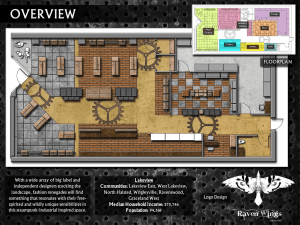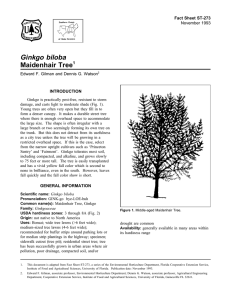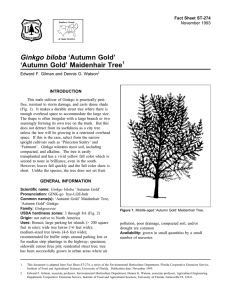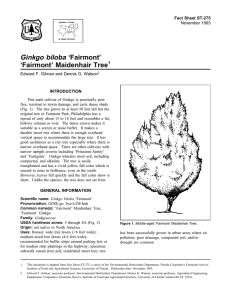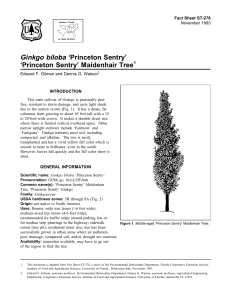Ginkgo biloba ‘Lakeview’ ‘Lakeview’ Maidenhair Tree Fact Sheet ST-277 1
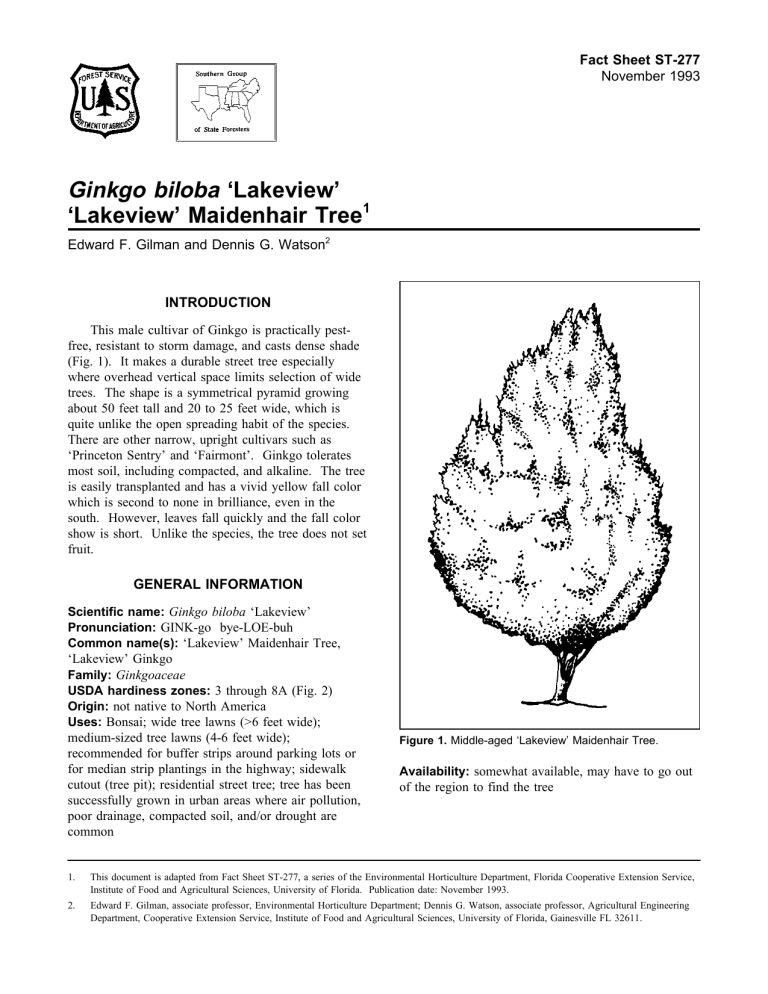
Fact Sheet ST-277
November 1993
Ginkgo biloba ‘Lakeview’
‘Lakeview’ Maidenhair Tree
1
Edward F. Gilman and Dennis G. Watson
2
INTRODUCTION
This male cultivar of Ginkgo is practically pestfree, resistant to storm damage, and casts dense shade
(Fig. 1). It makes a durable street tree especially where overhead vertical space limits selection of wide trees. The shape is a symmetrical pyramid growing about 50 feet tall and 20 to 25 feet wide, which is quite unlike the open spreading habit of the species.
There are other narrow, upright cultivars such as
‘Princeton Sentry’ and ‘Fairmont’. Ginkgo tolerates most soil, including compacted, and alkaline. The tree is easily transplanted and has a vivid yellow fall color which is second to none in brilliance, even in the south. However, leaves fall quickly and the fall color show is short. Unlike the species, the tree does not set fruit.
GENERAL INFORMATION
Scientific name: Ginkgo biloba ‘Lakeview’
Pronunciation: GINK-go bye-LOE-buh
Common name(s): ‘Lakeview’ Maidenhair Tree,
‘Lakeview’ Ginkgo
Family: Ginkgoaceae
USDA hardiness zones: 3 through 8A (Fig. 2)
Origin: not native to North America
Uses: Bonsai; wide tree lawns (>6 feet wide); medium-sized tree lawns (4-6 feet wide); recommended for buffer strips around parking lots or for median strip plantings in the highway; sidewalk cutout (tree pit); residential street tree; tree has been successfully grown in urban areas where air pollution, poor drainage, compacted soil, and/or drought are common
Figure 1. Middle-aged ‘Lakeview’ Maidenhair Tree.
Availability: somewhat available, may have to go out of the region to find the tree
1.
This document is adapted from Fact Sheet ST-277, a series of the Environmental Horticulture Department, Florida Cooperative Extension Service,
Institute of Food and Agricultural Sciences, University of Florida. Publication date: November 1993.
2.
Edward F. Gilman, associate professor, Environmental Horticulture Department; Dennis G. Watson, associate professor, Agricultural Engineering
Department, Cooperative Extension Service, Institute of Food and Agricultural Sciences, University of Florida, Gainesville FL 32611.
Ginkgo biloba ‘Lakeview’ -- ‘Lakeview’ Maidenhair Tree Page 2
Figure 2. Shaded area represents potential planting range.
DESCRIPTION
Height: 50 to 60 feet
Spread: 20 to 30 feet
Crown uniformity: symmetrical canopy with a regular (or smooth) outline, and individuals have more or less identical crown forms
Crown shape: pyramidal; upright
Crown density: dense
Growth rate: slow
Texture: medium
Foliage
Leaf arrangement: alternate (Fig. 3)
Leaf type: simple
Leaf margin: lobed
Leaf shape: fan-shaped
Leaf venation: parallel; palmate
Leaf type and persistence: deciduous
Leaf blade length: 2 to 4 inches
Leaf color: green
Fall color: yellow
Fall characteristic: showy
Flower
Flower color: green
Flower characteristics: pleasant fragrance; inconspicuous and not showy; spring flowering
Fruit
There is no fruit on this tree.
Trunk and Branches
Trunk/bark/branches: droop as the tree grows, and will require pruning for vehicular or pedestrian clearance beneath the canopy; showy trunk; should be grown with a single leader; no thorns
Pruning requirement: needs little pruning to develop a strong structure
Breakage: resistant
Current year twig color: brown; gray
Current year twig thickness: medium; thick
Ginkgo biloba ‘Lakeview’ -- ‘Lakeview’ Maidenhair Tree Page 3
Figure 3. Foliage of ‘Lakeview’ Maidenhair Tree.
Culture
Light requirement: tree grows in part shade/part sun; tree grows in full sun
Soil tolerances: clay; loam; sand; acidic; occasionally wet; alkaline; well-drained
Drought tolerance: high
Aerosol salt tolerance: moderate
Soil salt tolerance: poor
Other
Roots: surface roots are usually not a problem
Winter interest: tree has winter interest due to unusual form, nice persistent fruits, showy winter trunk, or winter flowers
Outstanding tree: tree has outstanding ornamental features and could be planted more
Invasive potential: little, if any, potential at this time
Verticillium wilt susceptibility: not known to be susceptible
Pest resistance: no pests are normally seen on the tree
USE AND MANAGEMENT
Ginkgo may grow extremely slow for several years after planting, but will then pick up and grow at a moderate rate, particularly if it receives an adequate supply of water and some fertilizer. But do not overwater or plant in a poorly-drained area. Keep turf away from several feet around the trunk to help the tree become established. Very tolerant of urban soils and pollution, Ginkgo could be used more in USDA hardiness zone 7 but is not recommended in central and southern Texas or Oklahoma due to summer heat.
Adapted for use as a street tree, even in confined soil spaces. Some early pruning to form one central leader and to eliminate vigorous upright branches is helpful.
There are several cultivars: ‘Autumn Gold’ - male, fruitless, bright gold fall color and rapid growth rate;
‘Fairmont’ - upright, oval to pyramidal form;
‘Fastigiata’ - male, fruitless, upright growth;
‘Laciniata’ - leaf margins deeply divided; ‘Mayfield’ male, fruitless, upright fastigiate (columnar) growth;
‘Pendula’ - pendent branches; ‘Princeton Sentry’ male, fruitless, fastigiate, narrow conical crown for restricted overhead spaces, popular, 65 feet tall, available in some nurseries; ‘Santa Cruz’ - umbrellashaped, ‘Variegata’ - variegated leaves.
Propagation is by seed or grafting males.
Pests and Diseases
This tree is pest-free and considered resistant to gypsy moth.
